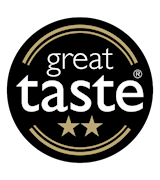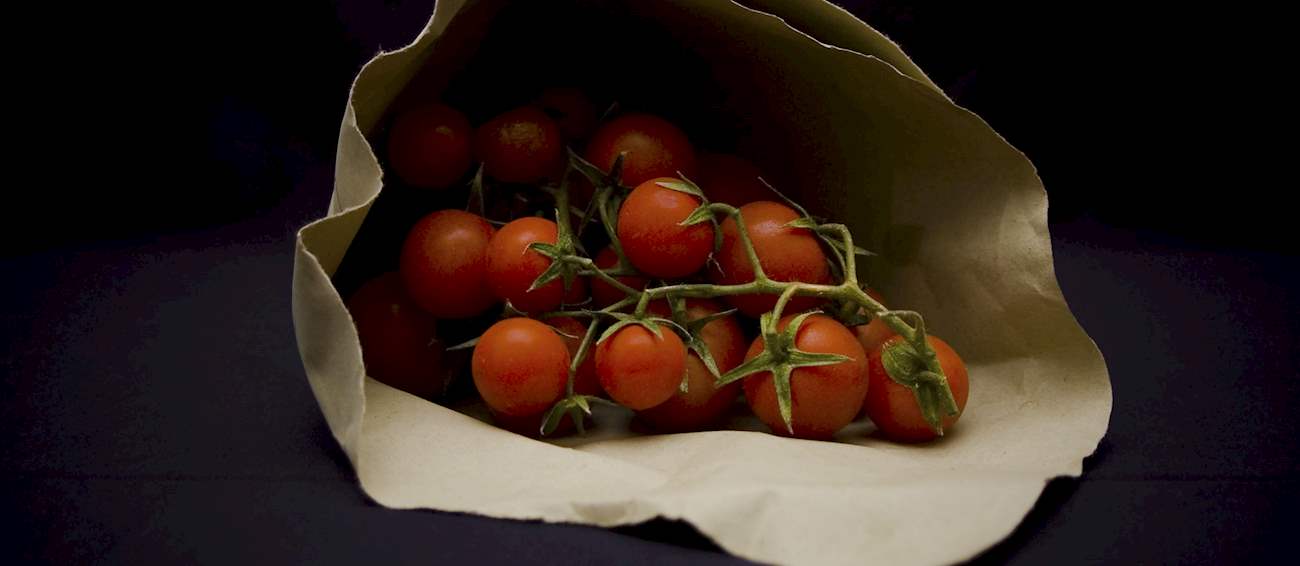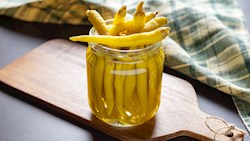Best Vegetable Types in the World
These small tomatoes come from a local variety produced on the islands of Santorini, Thirasia, Palea Kameni, Nea Kameni, Aspro, Christiani, and Askania in the Cyclades in the southern Aegean Sea. The production, treatment, and processing of these tomatos must be carried out exclusively within this area in order to avoid deterioration in the quality of this fragile fruit.
Tomataki Santorinis is a deep red color and has a firm, not particularly moist flesh with a high seed content. These tomatoes owe their distinctive characteristics to the climatic conditions and the limey, alkaline soils of the area. It has high levels of acidity and, due to the alkaline soil, a high sugar level when ripe.
Named after its town of origin, pomodoro di Pachino refers to various varieties of fresh tomatoes grown within the Sicilian province of Syracuse. The sweet flavored Pachino tomatoes are characterized by a particularly succulent flesh and prized for their long shelf life.
They are best enjoyed fresh, and typically used as an ingredient for mixed salads, cold pasta dishes or for pizza toppings. Also, according to old Sicilian culinary traditions, Pachino tomatoes are often sun-dried and preserved in olive oil in which way they can be used for making pâtés and tapenades, various flans and a seemingly limitless number of pasta dishes.
Prized by many chefs as the best of its kind, Pomodoro S. Marzano dell’Agro Sarnese-Nocerino is a variety of plum tomato grown along the banks of Sarno River in the fertile volcanic plains south of Mount Vesuvius, namely within the provinces of Naples, Salerno and Avellino.
Locally known as 'the king of tomatoes', San Marzano peels quite easily and is characterized by an almost seedless flesh, bright red color and a delicate, bittersweet flavor. Even though San Marzano tomatoes are commonly used in a wide variety of Italian dishes, they have been designated as the only tomato variety that can be used for Vera Pizza Napoletana, the genuine Neapolitan pizza.
Aji amarillo is a staple in Peruvian cuisine, a chile pepper with a bright orange color and thick flesh. Its heat level ranges from medium to hot, and it is commonly used in a variety of soups and sauces. This chile variety is native to South America and has a distinctive, subtle, and full-bodied fruitiness.
It can be bought in a few forms: dried, fresh, canned, or in the form of a paste. When incorporated into sauces, it is often thickened with bread, mayonnaise, and dairy products, and it is then spooned over a variety of meat, fish, and vegetable dishes.
Aji límo (also known as lemon drop pepper) is a Peruvian hot pepper with a citrusy tang and a Scoville heat unit of 15,000-30,000. When mature, its color becomes golden-yellow, and the flavor becomes fruity, with some people comparing it to fresh lemongrass.
This chili variety is ideal for spicy salsas, hot sauces, and dishes based on chicken or fish. In Peru, it is often used as a seasoning for various main meals and snacks.
Named after the Calabrian town of Tropea settled along the Tyrrhenian coast in the province of Vibo Valentia, Cipolla Rossa di Tropea Calabria refers to the red onions of the following cultivars: Tondo Piatta (early ripening), Mezza Campana (mid-season) and Allungata (late ripening).
They are further categorized into three types: Cipollotto (scallion), Cipolla da Consumo Fresco (fresh onion) and Cipolla da Serbo (preserved onion). Fully ripe Tropea onions are either round or slightly elongated, succulent and particularly sweet.
This potato is cultivated in the municipalities of Kato Nevrokopi, Kato Vrontos, Perithori, Dasoto, Lefkogia, Khrisokefalos, Okhiro, Vathitopos, and Katafitos. These potatoes were first grown in the area in the 1920s, and they have since enjoyed great popularity among consumers due to their superior quality.
Kato Nevrokopi potatoes are high in carbohydrates, starch, and proteins thanks to the region's excellent climatic conditions and sandy soils. They are cultivated in the summer to be harvested in September, when the temperature is lower and precipitation is higher.
Makói hagyma is a strong tasting, round onion from the Makó region in Hungary that has a very high dry matter percentage and firm, white flesh. The town of Makó is also called the "Hungarian onion capital", and holds an annual Onion Festival where one can sample tasty dishes made with these onions - bread, strudels, scones and others.
The high dry matter content in the onion is due to the dry weather season at the end of summer, resulting in an onion which does not spoil easily and has a long shelf life. Its skin is bronze-red in colour and its strong, hot taste is owed to the high amounts of allyl sulphide (a colourless liquid with an intense smell)found in the Makoi hagyma.
These are Liseta, Spunta, Marfona, Vivaldi, and Alaska variety potatos grown on the island of Naxos. They have a smooth yellow skin and contain over 18% starch and less than 1% sugar. These potatos are harvested by hand twice a year, from mid-February to March and from August to September.
Since they are harvested earlier than other potatoes, they is highly sought after on the market and fetch a higher price. Patata Naxou is famous throughout Greece, and is one of the main ingredients in many recipes. To promote this tasty potato, Naxos local authorities hold the Annual Naxos Potato Festival every August, which has marked a 10% increase in attendance every year.
Yukon Gold is an all-purpose potato with yellow skin and yellow flesh. These potatoes are usually round or oblong and slightly flattened. Their skin is dotted with small brown spots, while the flesh is firm, moist, and waxy. Yukon Gold potatoes were created in Canada, as a cross between the North American white potatoes and the yellow-fleshed South American potatoes.
They were first released to the market in 1980. Because of their medium-starch content, these potatoes are incredibly versatile, and they can be used in a variety of dishes. They are suitable for boiling, frying, roasting, mashing, grilling, and sautéing.
Best Vegetable Producers in the World
AWARDS

Global Cheese Awards - Gold
2023, 2018

International Cheese Awards - Gold
2023, 2022, 2019

Great Taste Awards - 2 stars
2023
BEST Arla Cheeses
E. A. S. Naxos was founded in 1926 and is a key player in Naxos's agricultural sector, especially known for its dairy and cheese production. This cooperative is significant for its contributions to the local economy and for supporting the agricultural activities on the island.
E. A. S. Naxos has several primary products, with Graviera Naxou P. D. O. cheese being its most famous. This cheese is protected under the Protected Designation of Origin status, signifying its unique regional characteristics. The cooperative also produces other dairy products and operates a modern milk processing plant.
AWARDS

Taste Olymp Awards - Gold
2017
AWARDS

Great Taste Awards - 2 stars
2024, 2022
BEST Hodi Paprika Herbs and Spices
El Navarrico is a family-owned company founded in 1960 by José Salcedo and his wife Amalia in San Adrián, Navarra, Spain. They began with the handcrafted production of canned asparagus and piquillo peppers in a modest workshop located beneath their family home.
Today, El Navarrico operates a 10,000-square-meter production facility and offers over 250 high-quality gourmet products, including vegetables, legumes, fruits, and ready-to-eat meals. Their products are renowned for preserving the authentic flavors of the Navarra region, achieved through a combination of traditional methods and innovative techniques.
AWARDS

Great Taste Awards - 2 stars
2021
Best Vegetables in the World
AWARDS

Great Taste Awards - 2 stars
2024
TasteAtlas food rankings are based on the ratings of the TasteAtlas audience, with a series of mechanisms that recognize real users and that ignore bot, nationalist or local patriotic ratings, and give additional value to the ratings of users that the system recognizes as knowledgeable. For the “Top 100 Vegetables in the World” list until February 14, 2025, 5,816 ratings were recorded, of which 3,254 were recognized by the system as legitimate. TasteAtlas Rankings should not be seen as the final global conclusion about food. Their purpose is to promote excellent local foods, instill pride in traditional dishes, and arouse curiosity about dishes you haven’t tried.






























































































































